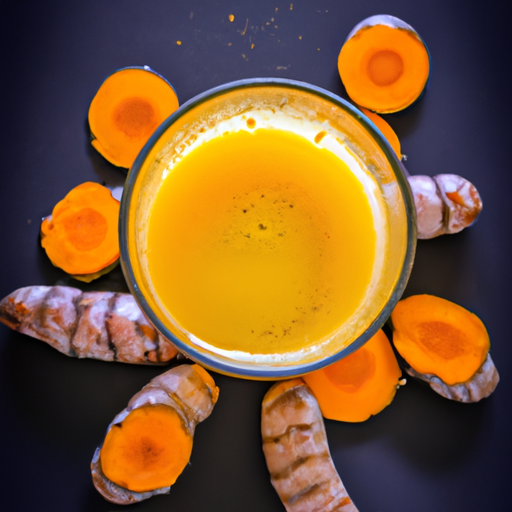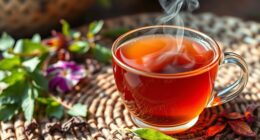Did you know that our skin is the largest organ of our body? It serves as a protective barrier against external elements and plays a crucial role in maintaining our overall health.
However, factors like stress, pollution, and aging can take a toll on our skin, causing various issues such as acne, inflammation, and dullness.
But here’s an interesting statistic for you: did you know that turmeric tea has been used for centuries to promote healthy and radiant skin? That’s right! This golden-hued beverage, derived from the roots of the turmeric plant, is packed with potent antioxidants and anti-inflammatory compounds that can work wonders for your skin.
In this article, I will delve into the origins of turmeric tea, highlight its key nutrients, and explore the potential skin benefits it offers. I will also guide you on how to make this soothing tea and reveal ways to incorporate it into your skincare routine.
However, it’s important to note that turmeric tea may not be suitable for everyone, so I will also discuss precautions and potential side effects.
So, let’s dive in and discover why turmeric tea is a game-changer for your skin.
Key Takeaways
- Turmeric tea is rich in antioxidants and anti-inflammatory compounds that promote healthy and radiant skin.
- Turmeric tea can reduce redness, inflammation, and the appearance of dark spots, resulting in a more even skin tone.
- Turmeric tea can treat acne, blemishes, and acne scars due to its antibacterial and anti-inflammatory properties.
- Precautions should be taken when using turmeric tea to prevent staining and to consult with a healthcare professional for proper dosage and usage.
Origins of Turmeric Tea
Did you know that the origins of turmeric tea can be traced back thousands of years, offering a rich history and cultural significance that adds depth to its skin-loving benefits?
Turmeric, scientifically known as Curcuma longa, is a perennial plant native to South Asia, particularly India and Indonesia. This vibrant golden spice has been cultivated in these regions for over 4,000 years, and its traditional uses extend far beyond its culinary applications.
Turmeric cultivation dates back to ancient times, where it was highly valued for its medicinal properties. In Ayurvedic medicine, turmeric was used to treat various ailments, including skin conditions, due to its anti-inflammatory and antioxidant properties. It was also used as a beauty aid to enhance the skin’s natural radiance and improve complexion.
The traditional uses of turmeric have paved the way for the creation of turmeric tea, a beverage that harnesses the potential benefits of this remarkable spice. By steeping turmeric in hot water, the tea becomes infused with the key nutrients present in the spice, including curcumin, the active compound responsible for its powerful antioxidant and anti-inflammatory effects.
Transitioning into the subsequent section about the key nutrients in turmeric tea, it is important to understand how these compounds contribute to its skin-loving benefits.
Key Nutrients in Turmeric Tea
One of the main benefits of incorporating turmeric tea into your routine is that it contains essential nutrients that help promote a healthy complexion. Turmeric tea is packed with key nutrients that are beneficial for the skin. Here are four reasons why turmeric tea can be beneficial for your skin:
-
Antioxidants: Turmeric tea is rich in antioxidants, which help protect the skin from damage caused by free radicals and environmental factors.
-
Anti-inflammatory properties: The active compound in turmeric, known as curcumin, has anti-inflammatory properties that can help reduce redness and inflammation, making it beneficial for those with acne or inflammatory skin conditions.
-
Skin brightening: Turmeric tea has been used for centuries to improve the appearance of the skin. Its natural skin brightening properties can help reduce the appearance of dark spots and promote a more even skin tone.
-
Hydration: Staying hydrated is essential for maintaining healthy skin. Drinking turmeric tea can help keep your skin hydrated and nourished.
With these turmeric tea benefits in mind, let’s explore the potential skin benefits of turmeric tea in the next section.
Potential Skin Benefits of Turmeric Tea
I’ve found that turmeric tea has the potential to provide several skin benefits. Firstly, it can help reduce inflammation and redness, which is particularly beneficial for those with sensitive or acne-prone skin. Secondly, turmeric tea has been shown to be effective in treating acne and blemishes, thanks to its anti-inflammatory and antibacterial properties. Lastly, this tea can also brighten and even out skin tone, giving a more radiant and youthful appearance.
Reducing inflammation and redness
To soothe irritated skin and calm redness, you can try incorporating turmeric tea into your skincare routine. Turmeric contains a compound called curcumin, which has been shown to have anti-inflammatory properties. By reducing inflammation, turmeric tea can help alleviate redness and soothe irritation. Here are three ways that turmeric tea can benefit your skin:
-
Decreases redness: The anti-inflammatory properties of curcumin can help reduce redness caused by conditions like rosacea or sunburn.
-
Calms irritation: Turmeric tea can help calm irritated skin by reducing inflammation and soothing any discomfort.
-
Enhances skin tone: Turmeric tea may improve your skin’s overall appearance by evening out skin tone and reducing redness.
By incorporating turmeric tea into your skincare routine, you can reduce inflammation, soothe irritation, and improve your skin’s overall appearance. This natural remedy can be a helpful addition to your efforts in treating acne and blemishes.
Treating acne and blemishes
Transform your troubled complexion by incorporating turmeric tea into your skincare routine. This powerful remedy has been shown to effectively treat acne and blemishes. Turmeric contains curcumin, a compound known for its anti-inflammatory and antibacterial properties. By reducing inflammation and killing acne-causing bacteria, turmeric tea can help clear existing breakouts and prevent new ones from forming.
Additionally, turmeric tea can treat scars left behind by acne, promoting skin healing and reducing their appearance over time. Another benefit of turmeric tea is its ability to reduce oiliness. Excess oil production can contribute to clogged pores and breakouts, but the antioxidant properties of turmeric help regulate sebum production, resulting in a less oily complexion.
Transitioning into the next section, turmeric tea also has the potential to brighten and even out skin tone.
Brightening and evening out skin tone
By incorporating turmeric tea into my daily skincare routine, I can achieve a brighter and more even complexion. Turmeric has long been known for its brightening properties and is used in many natural skin remedies. Its active compound, curcumin, helps to reduce pigmentation and even out skin tone.
Additionally, turmeric has antioxidant and anti-inflammatory properties that can help to reduce redness and soothe the skin. Drinking turmeric tea regularly can also improve the overall health of the skin, as it helps to detoxify the body and promote a healthy digestive system.
Now that we know the benefits of turmeric tea for brightening the skin, let’s move on to how to make this beneficial beverage.
How to Make Turmeric Tea
Brewing a cup of turmeric tea is like adding a ray of sunshine to your skincare routine. Not only is turmeric tea a delicious and soothing beverage, but it also offers numerous benefits for your skin. The powerful antioxidant and anti-inflammatory properties of turmeric can help brighten and even out your skin tone, giving you a healthy and radiant complexion.
To make turmeric tea, start by boiling water and adding a teaspoon of ground turmeric. Allow it to simmer for about 10 minutes to release the active compounds. You can also add other ingredients like ginger, lemon, or honey to enhance the flavor and benefits. Strain the tea into a cup, and it’s ready to enjoy!
The turmeric tea recipe may vary depending on personal preferences, but the key is to ensure that you’re using high-quality turmeric powder for maximum effectiveness. Incorporating turmeric tea into your skincare routine can be as simple as drinking a cup every day or using it as a toner by applying it to your face with a cotton pad. By doing so, you can harness the natural goodness of turmeric to achieve a healthier and more vibrant complexion.
Incorporating Turmeric Tea into Your Skincare Routine
I’ve found that incorporating turmeric tea into my skincare routine has been incredibly beneficial for my skin. One way I like to use it is by making DIY turmeric face masks and scrubs. The anti-inflammatory properties of turmeric help to reduce redness and inflammation, leaving my skin looking clearer and more radiant.
Additionally, I’ve discovered that using turmeric tea as a toner or facial mist helps to balance my skin’s pH levels and minimize breakouts.
Lastly, adding turmeric tea to my bathwater has improved my overall skin health, as the antioxidants in turmeric help to detoxify and rejuvenate my skin.
DIY turmeric face masks and scrubs
To enhance your skincare routine, try incorporating DIY turmeric face masks and scrubs into your regimen. You can make DIY turmeric face masks by mixing turmeric powder with ingredients like yogurt, honey, or aloe vera gel. Turmeric contains curcumin, a compound known for its anti-inflammatory and antibacterial properties. When applied to the skin, turmeric can help reduce acne breakouts and calm redness and inflammation. Turmeric face masks can be used once or twice a week for best results.
Additionally, you can create a gentle turmeric scrub by combining turmeric powder with a natural exfoliant like sugar or oatmeal. Gently massage the scrub onto your skin to remove dead skin cells and reveal a brighter complexion.
Using turmeric tea as a toner or facial mist can further enhance the benefits of turmeric for your skin.
Using turmeric tea as a toner or facial mist
Incorporating turmeric tea as a toner or facial mist can amp up the nourishing effects of this golden ingredient on your complexion. Using turmeric tea as a facial cleanser can help you remove dirt, oil, and impurities from your skin, leaving it feeling clean and refreshed.
Turmeric tea is particularly beneficial for oily skin. It possesses natural astringent properties that can help reduce excess oil production and minimize the appearance of pores. Moreover, turmeric tea contains antioxidants and anti-inflammatory compounds that can soothe and calm irritated skin. These properties work together to reduce redness, inflammation, and acne breakouts.
By adding turmeric tea to your skincare routine, you can enhance the overall health and appearance of your skin.
Transitioning into the next section about adding turmeric tea to bathwater for overall skin health, it’s important to explore other ways turmeric can benefit your complexion.
Adding turmeric tea to bathwater for overall skin health
By immersing yourself in a turmeric-infused bath, you can indulge in a luxurious and rejuvenating experience that promotes overall skin health. Turmeric tea isn’t just great for internal consumption but can also be beneficial when used externally.
When added to bathwater, turmeric tea can provide a range of benefits for your skin. The anti-inflammatory properties of turmeric tea can help reduce redness and irritation, making it ideal for those with sensitive or acne-prone skin. The antioxidants in turmeric tea can combat free radicals, which can contribute to premature aging and dull skin. Additionally, turmeric tea can improve skin tone and texture, leaving your skin feeling soft and supple.
To enjoy these benefits, simply brew a strong cup of turmeric tea and add it to your warm bathwater. Soothe your senses and nourish your skin with this simple and natural remedy. However, it’s important to note that turmeric can stain fabrics and surfaces, so be cautious when using it in your bath.
In the next section, I’ll discuss the precautions and potential side effects of using turmeric tea on the skin.
Precautions and Side Effects
When incorporating turmeric tea into your skincare routine, it’s important to be aware of potential allergic reactions, interactions with certain medications, and the staining of clothing and surfaces. Allergic reactions to turmeric are rare but can occur, so it’s recommended to do a patch test before using it on your skin.
Turmeric can also interact with certain medications, such as blood thinners, so it’s important to consult with a healthcare professional if you’re taking any medications.
Additionally, turmeric can leave yellow stains on clothing and surfaces, so it’s advisable to be cautious and protect your belongings while using turmeric tea in your skincare routine.
Potential allergic reactions
Although turmeric tea can provide numerous benefits for the skin, individuals should be cautious of potential allergic reactions, as they could be a double-edged sword.
Allergies to turmeric can cause skin rashes, hives, and itching, which can be uncomfortable and bothersome. In severe cases, allergic reactions may lead to difficulty breathing, swelling of the face or throat, and even anaphylaxis, a life-threatening condition.
It’s important to be aware of these potential side effects and take necessary precautions before consuming turmeric tea for skin health. To minimize the risk of allergic reactions, it’s advisable to start with a small amount of turmeric tea and observe any adverse effects. Additionally, individuals with known allergies to turmeric or other spices should avoid consuming turmeric tea altogether.
Transitioning into the next section about interactions with certain medications, it’s important to consider potential drug interactions when incorporating turmeric tea into your skincare routine.
Interactions with certain medications
While turmeric tea has been praised for its potential benefits for the skin, it is important to be aware of its interactions with certain medications. Turmeric contains compounds that can interfere with the metabolism of certain drugs, leading to increased or decreased effectiveness. For example, turmeric may enhance the effects of blood-thinning medications, such as warfarin, increasing the risk of bleeding. On the other hand, it may reduce the effectiveness of drugs like cyclosporine, which is used to prevent organ rejection after transplantation. It is crucial to consult with a healthcare professional before incorporating turmeric tea into your routine, especially if you are taking any medications. They can provide personalized guidance and determine if any potential risks exist. Now, let’s move on to the next section and discuss the staining of clothing and surfaces.
Staining of clothing and surfaces
One thing to keep in mind is that turmeric can leave behind a vibrant yellow stain on clothing and surfaces. To prevent staining, here are some tips to consider:
-
Act quickly: The sooner you address the stain, the easier it’ll be to remove.
-
Blot, don’t rub: Gently blot the stain with a clean cloth or paper towel to avoid spreading it.
-
Cold water rinse: Rinse the affected area with cold water to dilute the stain.
-
Stain remover: Apply a stain remover or a mixture of detergent and water to the stain, then gently scrub.
Removing turmeric stains can be challenging, but with prompt action and the right techniques, it’s possible to minimize or eliminate the discoloration.
As we conclude, it’s important to be cautious when using turmeric to prevent any unwanted stains and protect your clothing and surfaces.
Conclusion and Final Thoughts
To wrap things up, let’s just say turmeric tea can do wonders for your skin and leave you feeling fabulous! As we discussed earlier, turmeric tea has numerous benefits for the skin. It can help reduce inflammation, fight acne-causing bacteria, and even out skin tone. However, it’s important to be aware of the potential staining of clothing and surfaces that can occur when using turmeric tea topically.
When it comes to turmeric tea, there are both pros and cons. On the positive side, it is a natural and cost-effective way to improve the health of your skin. It contains antioxidants that can help protect your skin from damage and aging. Additionally, it has anti-inflammatory properties that can soothe irritated skin and reduce redness.
On the other hand, staining can be a major drawback of using turmeric tea. The vibrant yellow color of turmeric can easily transfer onto clothing and surfaces, leaving behind stubborn stains that are difficult to remove. It’s important to take precautions when using turmeric tea topically, such as wearing old clothing or using a towel to protect surfaces.
In terms of recommended dosage, it is best to consult with a healthcare professional or dermatologist to determine the appropriate amount for your specific skin needs. They can provide guidance on how often to use turmeric tea and in what concentration to achieve optimal results without causing any adverse effects.
While turmeric tea can be a beneficial addition to your skincare routine, it’s important to consider the potential staining and take necessary precautions. Consulting with a healthcare professional can ensure you are using turmeric tea in a safe and effective manner.
Frequently Asked Questions
Can turmeric tea be used as a natural remedy for acne?
Yes, turmeric tea can be an effective natural remedy for acne. Its anti-inflammatory properties help reduce inflammation and redness associated with hormonal acne. Additionally, it helps balance oil production, making it beneficial for oily skin.
Are there any specific turmeric tea recipes that are beneficial for dry skin?
Sure, here’s a recipe for turmeric tea that can help soothe dry skin. Mix hot water, turmeric powder, honey, and a squeeze of lemon. The benefits of turmeric tea for eczema are well-known, so give it a try!
Does turmeric tea help with reducing dark spots and hyperpigmentation?
Yes, turmeric tea can help reduce dark spots and hyperpigmentation. Its anti-inflammatory and antioxidant properties can promote skin healing and reduce the production of melanin, leading to a more even skin tone.
Can turmeric tea be used as a facial toner?
Sure, turmeric tea can be used as a facial toner. Its anti-inflammatory properties and antioxidants make it a great option for reducing redness and promoting a healthy complexion. Plus, it’s a natural alternative to store-bought toners.
Are there any potential interactions between turmeric tea and skincare products containing retinol?
There is limited evidence on potential interactions between turmeric tea and skincare products containing retinol. Turmeric tea may have potential benefits for overall skin health, while retinol plays a role in skincare. Further research is needed to understand any possible interactions.
Conclusion
In conclusion, turmeric tea is a powerful elixir for achieving healthy and radiant skin. It’s origins are rooted in ancient Ayurvedic practices, and this golden beverage is packed with key nutrients like curcumin, vitamins, and antioxidants. Regular consumption of turmeric tea can help combat inflammation, promote collagen production, and enhance skin elasticity. You can easily incorporate this tea into your skincare routine by brewing a cup and applying it topically or using it as a facial steam. However, it’s important to exercise caution, as turmeric can stain the skin and clothing. Overall, turmeric tea is a natural and effective addition to your skincare regimen, helping you unveil a complexion that glows like the sun on a summer’s day.










